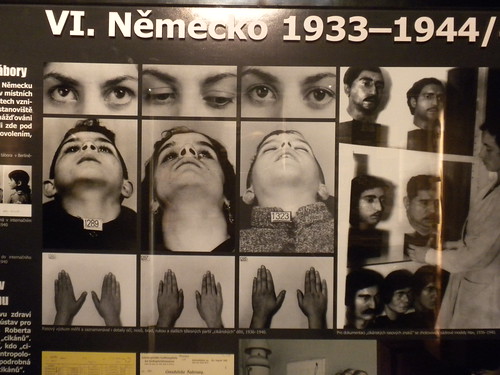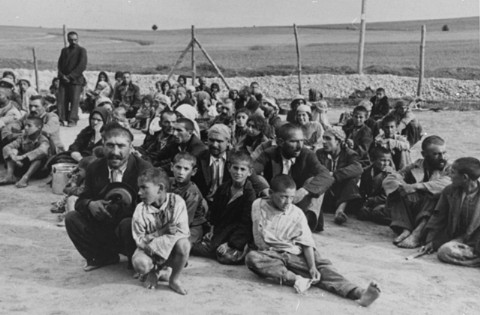The Holocaust.
That simple word is one of the main reasons I chose human rights as a career. It is one of the most obvious and well known cases of genocide. People around the world are still reeling from the Nazi “Final Solution.”
It has long been thought of in public consciousness (at least in the US, of European consciousness I cannot say,) that the Holocaust during WWII was a solely Jewish tragedy. Although Jewish individuals were the priority “problem” to Nazi Germany, many other groups were exterminated due to “racial inferiority” (see here) or based on politics, behavior, or ideological differences. Among the groups deemed necessary for extermination were mentally and physically disabled people, Russians, Poles, Communists, Jehovah’s Witnesses, Homosexuals, and Roma.

Eugenics were a major "scientific" reason to deem populations as racially inferior. This is a Roma woman being analyzed in Germany. Photo Credit: Museum of Romani Culture in Brno
This being a Peace Fellowship about the Roma in Europe, this blog will focus mostly on the forgotten holocaust of the Roma. However, everyone, please take a moment to remember the estimated 5 million non Jewish victims and 6 million Jewish victims of one of the most atrocious, systematic crime against humanity the Earth has ever seen.

Belzec Labor Camp in Poland, 1940. Photo Credit: US Holocaust Memorial Museum
The fate of the Roma followed in a similar fate to many of those deemed “undesirable” by the Third Reich. They were rounded up and put into internment camps where they would be away from “normal society.” Then work camps became the go to location for slowly killing entire families of Roma. Two of these “work” camps were located in what is now the Czech Republic, but during WWII was known as the Protectorate of Bohemia and Moravia. These camps, Lety in Bohemia and Hodonin in Moravia, were some of the most deadly work camps in the Nazi regime. (For perspective – the famous camp Dachau had a death rate of around 12%, whereas the camps at Lety and Hodonin the death rate was 20%). From Lety and Hodonin, large numbers of families were transported to one of the most famous extermination camps: Auschwitz-Birkenau.
At Auschwitz-Birkenau (truly in Birkenau proper) the Nazi regimes created a “Gypsy Family Camp,” where whole families were put together to slowly work themselves to death. However, on August 2, 1944, the SS guards killed 2,898 Roma individuals at Birkenau. Over the course of the war, of the 23,000 Roma individuals who were interred at Auschwitz-Birkenau, 19,000 were killed.
The remembrance of the atrocities that occurred during WWII is well documented in much of the Czech Republic. During my time as a Study Abroad student here, we visited the memorial of the site of what used to be the town of Lidice, a town that was randomly chosen for liquidation after the assassination of Reinhard Heydrich in Prague. We went to Terezin, the camp established as a “model” camp. The Red Cross even visited this camp and deemed it acceptable during the war. These are just two of the ways in which the deaths of Czech Jews and other civilians are memorialized.
However, despite the fact that around 90% of the Czech Roma population was exterminated during the Holocaust, the camps at Lety and Hodonin barely have any memorials. In fact, after the war, a state owned pig farm was established on the site of the former camp. Although a memorial has been established on the site of the former camp, it still borders the pig farm and is seen as a symbol of Czech intolerance and hatred towards the Roma population.

The Pig Farm at Lety u Pisku Roma Concentration Camp. Photo Credit: Czech Radio
A similar situation is seen at the camp at Hodonin, in which a recreation center was created on the grounds of the former concentration camp. However, in 2011, the government bought the camp with plans to create a memorial and learning center on the site. There is currently a small memorial which has been maintained by the Museum of Romani Culture in Brno.
The deaths of millions of innocent people occurred during the years of the Nazi regime. The remembrance efforts of governments has mostly been focused upon the Jewish victims of this time, but slowly there seems to be some effort to remember the other victims as well.
However, it is alarming and disheartening to see rhetoric which claimed the lives of 90% of the Czech Roma population in use today. An ad was run which claimed they would be the “final solution to the gypsy problem.” I was shocked. I asked many of the Roma individuals I work with and have interviewed about the rise of this extremist rhetoric. How could this propaganda resurface in the present day and age.
“Resurface?” said Petra Gelbart, a Czech-American Roma ethnomusicologist. “It never left.”
Posted By Beth Wofford
Posted Aug 3rd, 2011


